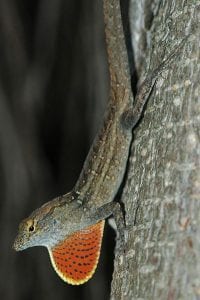Dartmouth professor Ryan Calsbeek and postdoctoral researcher Robert Cox recently found that intraspecific variation in sexual size dimorphism (SSD) in brown anole lizard (Anolis sagrei) can be attributed to underlying sex differences in responses to local variation of environmental conditions, rather than solely to natural selection. The finding is scheduled to be published in International Journal of Organic Evolution.
Sexual size dimorphism (SSD) occurs when males and females of a species differ systematically in body size. It is thought that this phenomenon is due to sex differences in the relationship between body size and survival (i.e., viability selection), fecundity (i.e., fecundity selection), and mating success (i.e., sexual selection).
The researchers simultaneously measured the fundamental role of sex-specific selection on body size and linked these selection pressures to SSD, an area that was relatively unknown. The researchers studied two geographically distinct populations of A. sagrei located on separate islands in The Bahamas, specifically Great Exuma and Eleutheqra. A. sagrei is a small lizard native to islands throughout the West Indies that persistently exhibits considerable variation in SSD on these two islands.
“Natural and sexual selection often differ dramatically between males and females, and this causes a genomic “tug-of-war” because genes that are favored in males are disfavored in females, and vice versa…Our primary goal was to determine whether this difference [SSD] occurs because natural selection favors different body sizes on each island,” said Cox.
The researchers found that the magnitude of SSD differs considerably between the two island populations of A. sagrei—a difference primarily driven by variation in the size of the males. Viability selection favored male-biased SSD on both islands though adult males grew more slowly on Eleuthera than on Exuma. While both sexes exhibited poorer body condition on Eleuthera than on Exuma, the growth of females did not differ between islands.
The study suggested that intraspecific variation in SSD in A. sagrei reflects both environmental variation in the energetic potential for rapid growth and sex-specific phenotypic plasticity in growth and body size.
“One exciting implication of our study is that it showed no difference in natural selection between populations, despite huge differences in sexual size dimorphism. We think that our data are more consistent with the interpretation that males are selected to be large on either island, but that they are energetically constrained from achieving their maximum potential sizes on one of the two islands. To really test this hypothesis, we would need to raise males and females from each population in a similar environment, such as at our laboratory facilities at Dartmouth!” said Cox.
